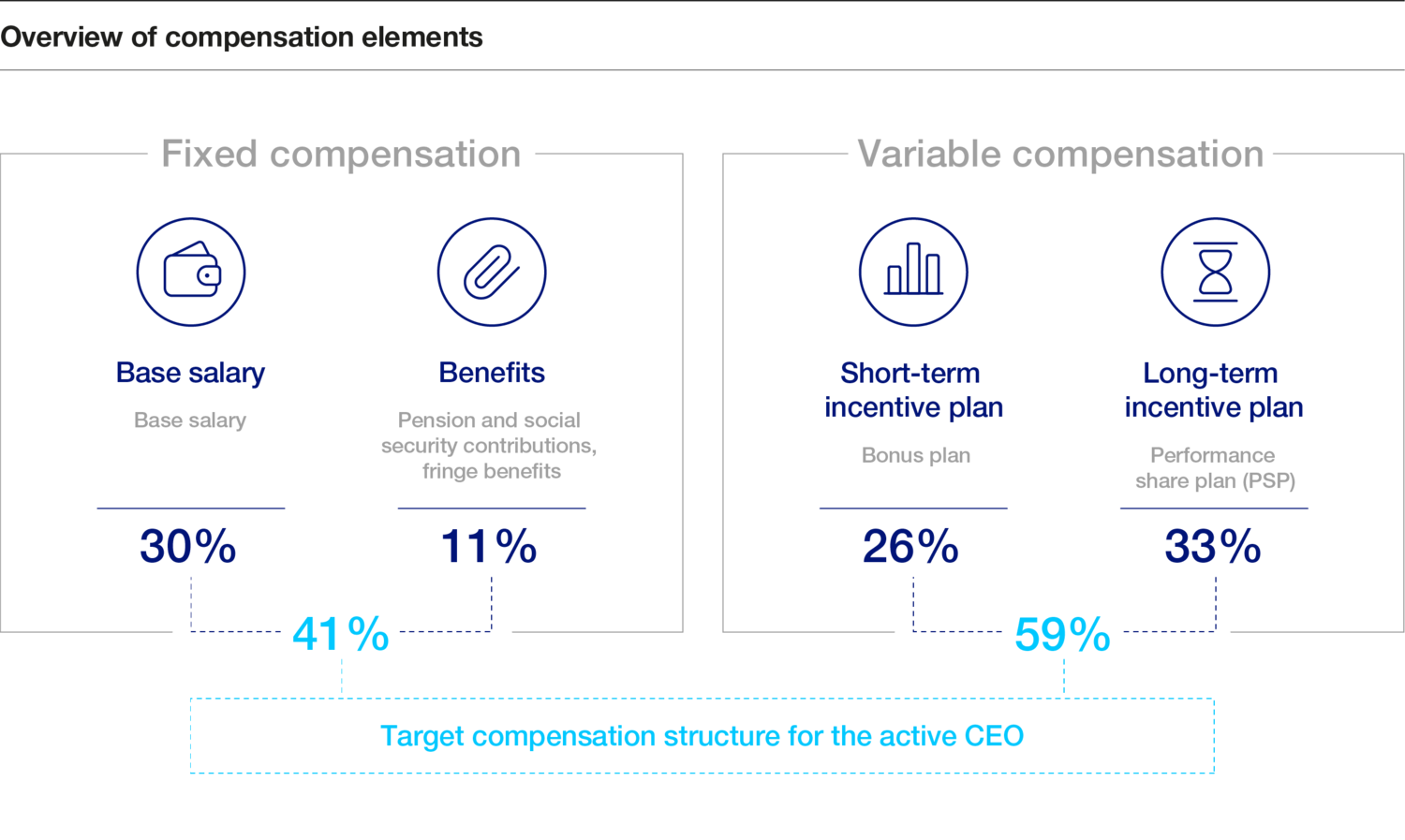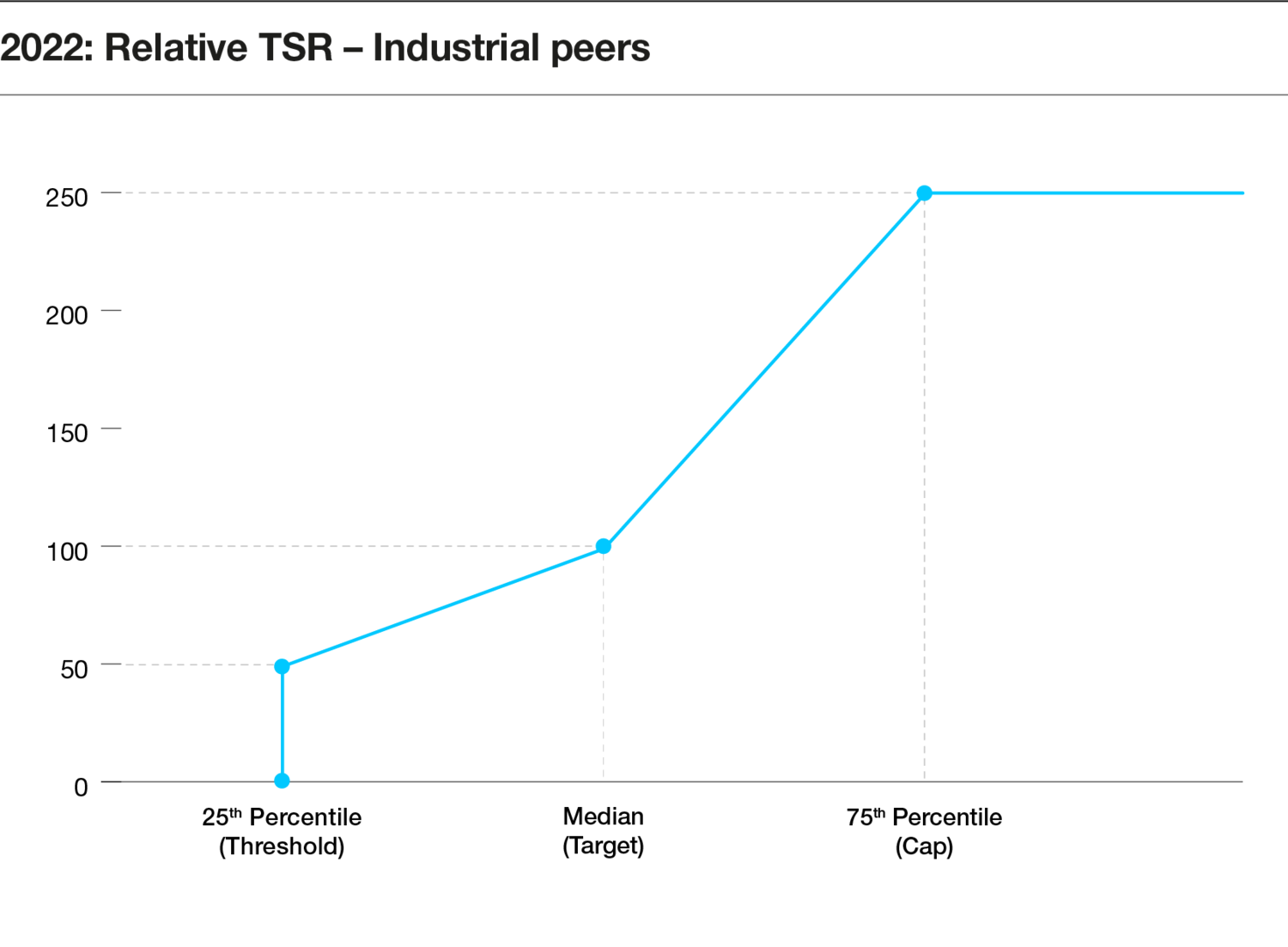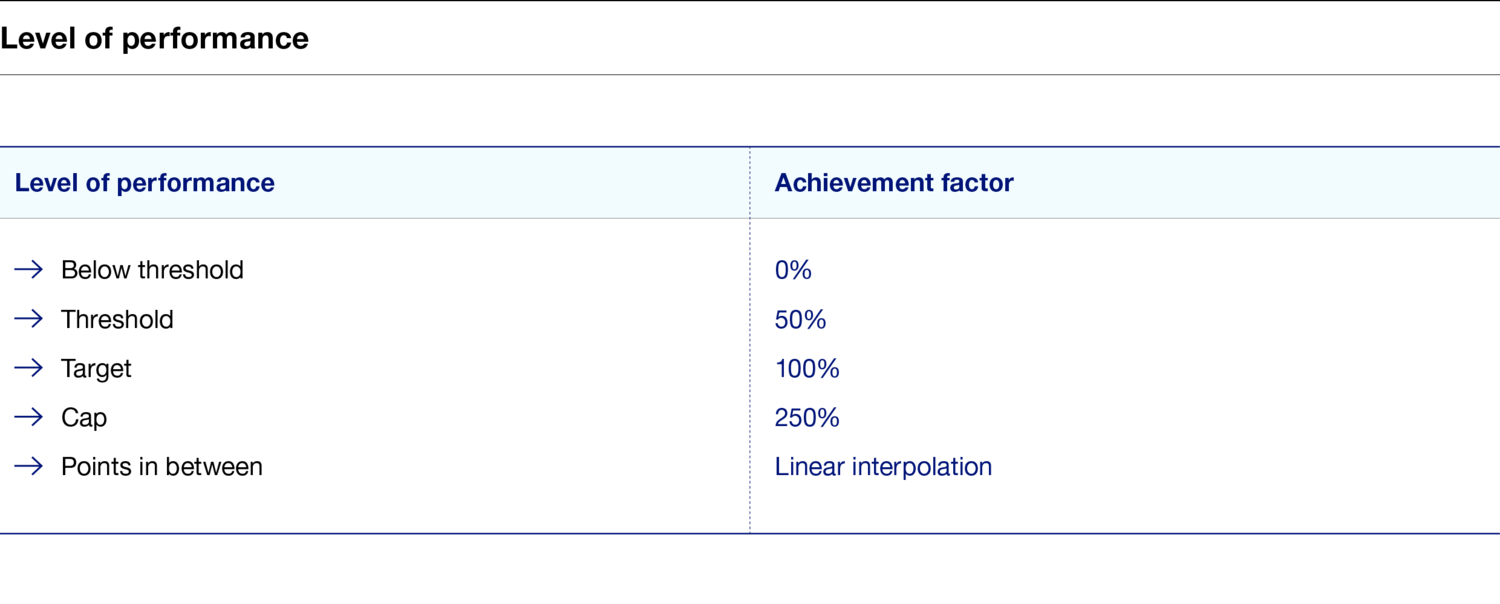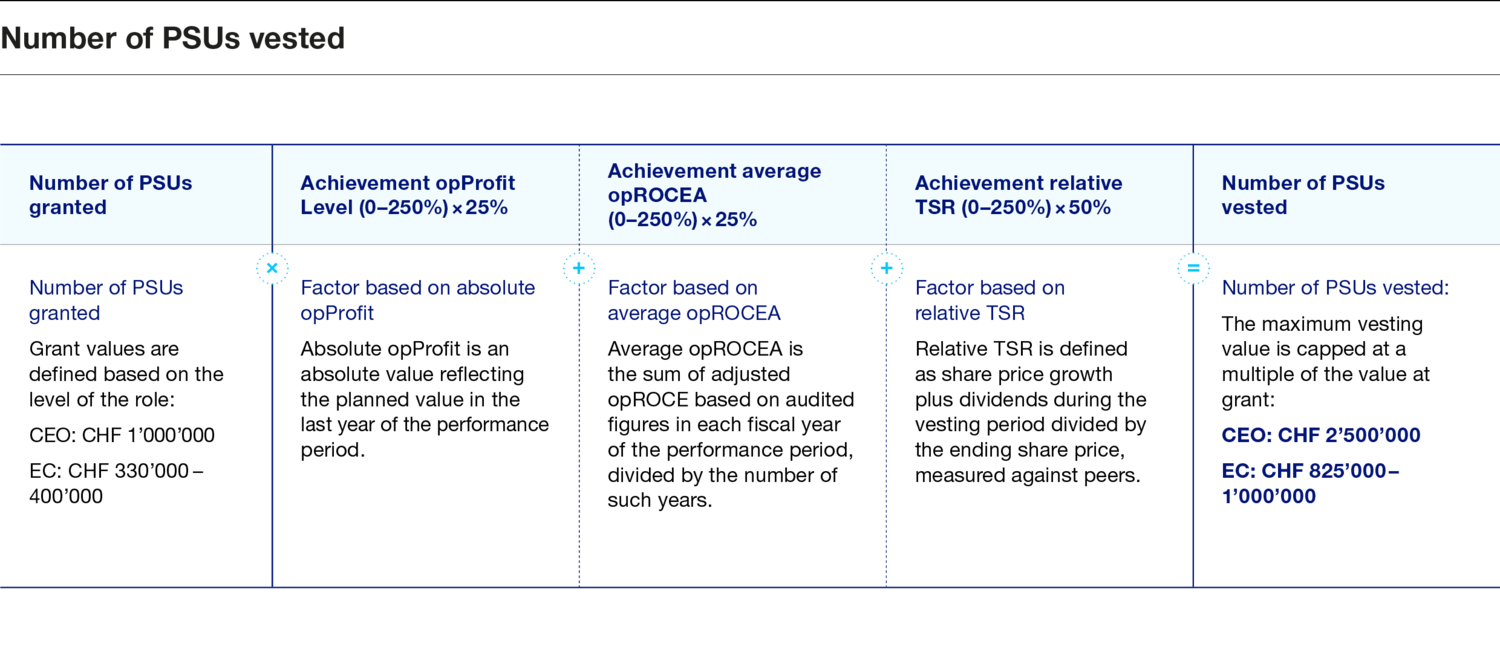– Compensation report – Compensation architecture for the CEO and EC members
Compensation architecture for the CEO and Executive Committee members
Compensation principles
The compensation of the Executive Committee is driven by the main principle of pay‑for‑ performance. The compensation policy and programs are designed to reward performance, sustainable growth and long-term shareholder value creation, while offering competitive remuneration to be able to attract and retain highly qualified employees. The compensation principles are:
|
Risk |
|
Risk exposure |
|
Pay-for-performance |
|
A substantial portion of the compensation is delivered in the form of variable incentives based on company and individual performance. |
|
Strategy alignment |
|
The performance criteria are selected to create adequate incentives for achieving the operational and strategic objectives. |
|
Ownership |
|
Part of the compensation is delivered in the form of company equity to foster ownership and to align the interests of executives with those of shareholders. |
|
Market competitiveness |
|
Compensation levels are competitive and in line with market practice to attract and retain highly qualified employees. |
|
Internal equity |
|
The internal compensation structure is based on a job-grading methodology applied globally. |
|
Transparency |
|
Compensation programs are straightforward and transparently explained in the compensation report. |
Method of determining compensation: benchmarking
To ensure compensation levels that are competitive and in line with market practice, the compensation of the Board of Directors and of the Executive Committee is benchmarked against that of similar roles in comparable companies every one to two years.
The RC regularly reviews the composition of the peer group, which is applied for benchmarking purposes. In 2021, the committee decided to revise the composition of the peer group from 2022 onward. Twelve industrial companies of comparable size and complexity from the Swiss market form the peer group, which is used to derive the compensation levels for the Board of Directors and for the Executive Committee.
While the previous peer group represented a good benchmark in terms of sales and headcount, the market capitalization of the peer group was well above Sulzer’s value. With the new benchmarking peer group, all three criteria are comparable to Sulzer in size.
Compensation benchmark
The comparison group reflects Sulzer’s ambitious business strategy:
- ALSO
- Bucher Industries
- Clariant
- dormakaba
- Forbo
- Galenica
- Geberit
- Georg Fischer
- Landis + Gyr
- OC Oerlikon
- Schindler
- Sonova
The intention is to pay target compensation around the median of the relevant market. Nevertheless, compensation is not granted based on benchmark results alone. The role, responsibility, experience and in particular the difference between a new entrant to a role and someone with experience who has already demonstrated their impact in a similar role, are also criteria in determining remuneration. A globally applied job-grading methodology fosters internal equity.
The compensation of the Executive Committee is governed by internal regulations such as the total reward policy, the bonus plan, the performance share plan and benefits plans. The compensation of the Executive Committee is reviewed by the RC annually and, if necessary, adjusted and approved by decision of the Board of Directors based on a proposal by the RC. The compensation of the Executive Committee is summarized as follows:
Compensation elements for the members of the Executive Committee
|
|
|
Base salary |
|
Benefits |
|
Short-term incentive plan (bonus plan) |
|
Long-term incentive plan (PSP 2022) |
|
Share ownership guidelines (SOG) |
|
Main parameters |
|
Function, level of role, profile of incumbent (skill set, experience) |
|
Pension and social security contributions, fringe benefits |
|
Achievement of annual financial and individual objectives |
|
Achievement of long-term, company-wide objectives, share price performance |
|
Level of role |
|
Key drivers |
|
Labor market, internal job-grading |
|
Protection against risks, labor market, internal job-grading |
|
Operational profit, sales, operational operating net cash flow (operational ONCF) |
|
Operational profit growth, operational return on average capital employed adjusted (operational ROCEA), relative total shareholder return (TSR) |
|
Share price performance |
|
Link to compensation principles |
|
Competitive compensation |
|
Competitive compensation |
|
Pay-for-performance, strategy alignment |
|
Pay-for-performance, strategy alignment, ownership |
|
Ownership |
|
Vehicle |
|
Cash |
|
Pension and insurance plans, perquisites |
|
Cash |
|
Performance share units (PSUs) settled in shares |
|
Obligation to privately invest in Sulzer shares and to hold these shares until the end of the service period |
|
Amount |
|
Fixed |
|
Fixed |
|
Variable, capped at 200% of target bonus. Target bonus amounts to 90% of annual base salary for the CEO and 60% of annual base salary for the other members of the Executive Committee. Clawback provisions implemented. |
|
Variable. Grant value is defined based on the Global Grade and corresponds to CHF 1’000’000 for the CEO and between CHF 330’000 and CHF 400’000 for the other members of the Executive Committee (EC). Vesting payout percentage is capped at 250% and vesting value is capped at CHF 2’500’000 for the CEO and at CHF 825’000 to CHF 1’000’000 for the other members of the EC. Malus and clawback provisions implemented. |
|
CEO: 200% of base salary. Other members of the Executive Committee: 100% of base salary. |
|
Grant/vesting/payment date |
|
Monthly |
|
Monthly and/or annually |
|
March of the following year |
|
Grant: April 1, 2022 Vesting: December 31, 2024 Share delivery: March 2025 |
|
– |
|
Performance period |
|
– |
|
– |
|
1 year (January 1, 2022–December 31, 2022) |
|
3 years (January 1, 2022–December 31, 2024) |
|
– |
The compensation of the Executive Committee contains fixed, performance-independent elements to provide a secure income and to ensure that no unreasonable risks are taken. In order to create reasonable incentives for the Executive Committee, to align the interests of the Executive Committee and shareholders, to ensure pay-for-performance and implement the company’s strategy in the Executive Committee’s compensation, it contains also short‑ and long‑term performance‑dependent elements:

In line with the pay-for-performance principle, a significant portion of the compensation of the CEO (59%) and for the other members of the Executive Committee (52%) consists of variable incentives based on performance. Furthermore, the compensation structure ensures sustainable long-term growth, as the long-term variable compensation makes up the largest portion of the target total compensation (see “Overview of compensation elementsˮ).
Base salary (fixed, in cash)
The base salary is determined at the discretion of the Board of Directors based on the market value of the respective position and the incumbent’s qualifications, skillset and experience. An internal job-grading methodology provides orientation and fosters internal equity.
Benefits
Members of the Executive Committee participate in the regular employee pension fund applicable to all employees in Switzerland. The retirement plan consists of a basic plan that covers annual earnings up to CHF 149’125 per year and a supplementary plan in which income over this limit, up to the ceiling set by law, is insured (including variable cash remuneration). The contributions are age‑related and are shared between the employer and the employee.
Furthermore, each member of the Executive Committee is entitled to a representation allowance in line with the expense regulations for all members of management in Switzerland and approved by the tax authorities.
Bonus (variable, performance-based, cash remuneration)
The bonus rewards the financial performance of the company and/or its businesses, as well as the achievement of individual performance objectives over one calendar year. Performance objectives are defined at the beginning of the year during annual target setting. Achievement is assessed against each of those objectives after year-end and directly influences the variable incentive payouts.

The target bonus is expressed as a percentage of annual base salary. It amounts to 90% for the CEO and to 60% for the other members of the Executive Committee. For the CEO and the other members of the Executive Committee, 70% of the bonus is based on the achievement of financial objectives at company and/or division level, and 30% is based on the achievement of individual objectives as described below:
|
Category |
|
Weight |
|
Objectives |
|
Rationale |
|
|
|
CEO/CFO/ CHRO |
|
Division President |
|
Financial performance |
|
70% |
|
Operational profitability |
|
Measure of profitability (bottom line) |
|
Sulzer |
|
25% |
|
7.5% |
|
Division |
|
|
|
17.5% |
||||||||
|
Sales |
|
Measure of growth (top line) |
|
Sulzer |
|
25% |
|
7.5% |
||||
|
Division |
|
|
|
17.5% |
||||||||
|
Operational operating net cash flow (operational ONCF) |
|
Measure of cash generated |
|
Sulzer |
|
20% |
|
6% |
||||
|
Division |
|
|
|
14% |
||||||||
|
Individual performance |
|
30% |
|
Cost-effectiveness |
|
Objectives linked to cost reduction or optimization |
|
Individual |
|
10% |
|
10% |
|
Growth initiatives |
|
Include initiatives that support the growth of Sulzer, such as M&A projects, breaking into new markets or new accounts |
|
Individual |
|
5% |
|
5% |
||||
|
Faster and better |
|
Initiatives focused on the profitability of Sulzer, with objectives linked to speed (“faster”) and quality (“better”) |
|
Individual |
|
5% |
|
5% |
||||
|
Sustainable Sulzer |
|
Objectives linked to the three major priorities of Sulzer’s sustainability plan, namely minimizing our carbon footprint, enabling a low carbon society and engaging our employees and communities |
|
Individual |
|
10% |
|
10% |
||||
|
|
|
|
|
|
|
|
|
Total |
|
100% |
|
100% |
The objectives are set within the annual target-setting process. For each financial objective, the following parameters are set upfront:
- An expected level of performance (“targetˮ), the achievement of which leads to a payout factor (on the respective performance metric) of 100%.
- A minimum level of performance (“thresholdˮ), below which the respective payout factor is zero.
- A maximum level of performance (“capˮ), above which the respective payout factor is capped at 200%.
Between threshold and target, as well as between target and cap, the payout factor is interpolated linearly.
In order to measure individual performance, each Executive Committee member is given different personal objectives for each of the four individual performance categories (“Cost-effectivenessˮ, “Growth initiativesˮ, “Faster and betterˮ and “Sustainable Sulzerˮ) at the beginning of the financial year. The CEO reviews the individual performance based on the personal objectives of each Executive Committee member, which in turn is reviewed by the RC. The CEO’s individual performance is assessed by the RC.
“Cost‑effectivenessˮ, for example, includes objectives like cost-saving (travel spend reduction, real estate cost reduction, etc.), whereas objectives for the category “Faster and better” considers, among others, on-time delivery percentage improvement. “Growth initiatives” include, for example, successful completion of M&A actions or sales growth in specific countries.
The “Sustainable Sulzerˮ criteria used to assess the performance of the Executive Committee are structured around the three major priorities of Sulzer’s sustainability plan, namely minimizing our carbon footprint, enabling a low‑carbon society and engaging our employees and communities. The following topics are examples that could be considered for the Executive Committee:
|
Minimizing carbon footprint |
|
Enabling a low-carbon society |
|
Engaging employees and communities |
|
Reduction of greenhouse gas emissions |
|
Increase in the energy efficiency of our products |
|
Employee engagement |
|
Energy consumption, and the supply of decarbonized energy to our production sites |
|
Solutions to treat wastewater and provide access to water for populations that are deprived of it |
|
Employee accident rate |
|
Reduction of waste and the recycling of our waste |
|
Low-carbon or decarbonized solutions such as the conversion of waste into eco-fuel or the capture of CO2 |
|
Number of employees enrolled in the health and wellbeing program, Sulzer in Motion |
|
|
|
Circular economy |
|
|
Sulzer strives for transparency in relation to pay-for-performance. However, further disclosure of financial and individual objectives may create a competitive disadvantage to the company, because it would reveal sensitive insights into Sulzer’s strategy. To ensure transparency while avoiding competitive risk, Sulzer provides a general performance assessment for each financial objective as well as the aggregated individual performance at the end of the performance cycle (see chapter “Compensation of the Executive Committee for 2022”).
On the basis of this performance assessment, a payout factor is determined for each financial objective as a result of the actual performance. The weighted average of the resulting payout factors on each performance metric will be multiplied by the target bonus amount to derive the actual bonus, which will be paid out in March of the following year.

The objectives for the bonus plan are linked to Sulzer’s strategic goal of promoting the sustainable and profitable growth of the company. They are chosen to provide different incentives for growth and shareholder value creation.
Strategic link of bonus plan
|
|
|
Growth |
|
Profitability |
|
Long-term shareholder value creation |
|
Bonus plan |
|
|
|
|
|
|
|
Operational profit |
|
|
|
|
|
|
|
Sales |
|
|
|
|
|
|
|
Operational ONCF |
|
|
|
|
|
|
|
Cost-effectiveness |
|
|
|
|
|
|
|
Growth initiatives |
|
|
|
|
|
|
|
Faster and better |
|
|
|
|
|
|
|
Sustainable Sulzer |
|
|
|
|
|
|
Performance share plan (variable, performance-based, share-based remuneration)
The long-term shareholder orientation and value creation is incentivized by a performance share plan (PSP) granting performance share units (PSUs) to the members of the Executive Committee. PSUs are a conditional right to a certain number of shares of the company, subject to ongoing employment and to the achievement of strategic/financial performance targets at Group level over the three-year performance period. The PSP is based on the performance of the company over three years and aligns the interests of the participants with those of the shareholders by delivering a substantial portion of the compensation as company equity. This emphasizes and supports Sulzer’s focus on pay-for-performance and sustainable growth, with a long-term perspective and additional retention effect on employees.
The PSP is a plan with annual grants and is available exclusively to the members of the Executive Committee and of the Sulzer Management Group. The grant value is determined based on the level of the executive’s role and amounts to CHF 1’000’000 for the former CEO, Frédéric Lalanne, and CHF 1’000’000 for the current CEO, Suzanne Thoma, and to between CHF 330’000 and CHF 400’000 (determined by the Board of Directors) for the other members of the Executive Committee. The number of PSUs granted is calculated by dividing the grant value by the three-month volume-weighted average share price before the grant date (units prorated as per entry date into employment).
The key performance criteria measured over the three-year performance period of PSU are:
- Operational profit before restructuring, amortization, impairments and non-operational items growth, weighted at 25%
- Average operational return on capital employed (operational ROCEA), weighted at 25%
- Relative total shareholder return (TSR) weighted at 50% and measured based on the performance against international peers, measured as a percentile ranking
Peer group for relative TSR performance of PSP 2022
International peers
- Andritz
- Burckhardt Compression
- Ebara
- Flowserve
- ITT
- OC Oerlikon
- Pentair
- Wood Group
- Xylem
The Board of Directors can alter the composition of the peer group if deemed necessary, such as in the case of a merger or acquisition or any other change leading to a delisting or a fundamental change in the scope of the business of a peer group company. In such a situation, the Board will select new peer companies. There is a predefined successor list of companies to support the Board of Directors in the selection process.
The threshold, target and maximum for the relative TSR in the international peer group remained unchanged.

For each performance condition of the PSP, a threshold, target and cap performance level are determined, which in turn determine the achievement factor. Sulzer strives for transparency in relation to pay-for-performance and discloses all information whose exposure cannot lead to strategic disadvantages.
Disclosure of internal financial objectives may create a competitive disadvantage for the company because it could reveal sensitive insights into Sulzer’s strategy. To ensure transparency while avoiding competitive risk, Sulzer provides a general performance assessment for each performance criteria at the end of the performance cycle based on the following metric (see chapter “Compensation of the Executive Committee for 2022”).

On the vesting date, the number of vested PSUs is calculated by multiplying the initial number of PSUs granted by the weighted average of the achievement factor of each performance condition. For each vested PSU, a Sulzer share will be delivered to the participant.

However, while the above-mentioned performance assessment impacts the number of PSUs vested and, consequently, the number of shares delivered, there might also be an increase in value per share over the three-year performance period, which may have a relevant impact on the actually delivered total value after three years. Therefore, the number of vested PSUs is subject to an absolute value cap representing, in each case, 2.5 times the original grant value.
The objectives for the PSP are linked to Sulzer’s strategic goal of promoting the sustainable and profitable growth of the company. They are chosen to provide different incentives for growth and shareholder value creation.
Strategic link of PSP
|
|
|
Growth |
|
Profitability |
|
Long-term shareholder value creation |
|
PSP |
|
|
|
|
|
|
|
Operational profit growth |
|
|
|
|
|
|
|
Operational ROCEA |
|
|
|
|
|
|
|
Relative TSR |
|
|
|
|
|
|
In the event of termination of employment, the following provisions apply:
|
Type of termination |
|
Provision |
|
By the employer for cause |
|
Unvested PSUs are forfeited. |
|
As a result of retirement |
|
Vesting and performance measurement of PSUs continues according to plan, no early allocation of the shares. |
|
Any other reason |
|
The number of unvested PSUs vest on a pro rata basis (number of months between grant date and termination date) according to the achievement factor at the end of the vesting period. There is no early allocation of the shares. |
Upon the occurrence of a change of control, PSUs will vest immediately on a pro rata basis, subject to a performance assessment by the Board of Directors. In such a case, the Board of Directors may also determine a cash settlement of the awards.
Malus and clawback
The Board of Directors may determine that PSUs are forfeited in full or in part (malus) or that a vested award will be recovered in full or in part (clawback) in situations of material misstatement of the financial results, an error in assessing a performance condition or in the information or assumptions on which the award was granted or vested, serious reputational damage to the company, gross negligence, or willful misconduct on the part of the participant. In 2021, the clawback clause was extended to cover bonuses, whereby Sulzer may recover in full or in part any relevant bonus compensation from Executive Committee members in situations of material misstatement of the financial results, an error in assessing a performance condition or gross misconduct of the participant.
Further information on share-based compensation can be found in note 32 to the consolidated Financial Statements of Sulzer Ltd.
Contracts of employment
The employment contracts of the Executive Committee are of undetermined duration and have a notice period of a maximum of 12 months. Members of the Executive Committee are not entitled to any impermissible severance or change of control payments. The employment contracts of the Executive Committee may include non-competition agreements with a time limit of one year and with maximum total compensation of one annual target compensation.
Shareholding requirements
Shareholding requirements for members of the Executive Committee were introduced with effect from 2020. According to these share ownership guidelines (SOG), the members of the Executive Committee are obliged to hold part of their shares until the end of their service period. The value of the shares to be held is set at 200% of the annual gross base salary for the CEO and 100% of the annual gross base salary for the other members of the Executive Committee.
|
Function |
|
Shareholding requirement in % of base salary |
|
CEO |
|
200% |
|
Other Executive Committee members |
|
100% |